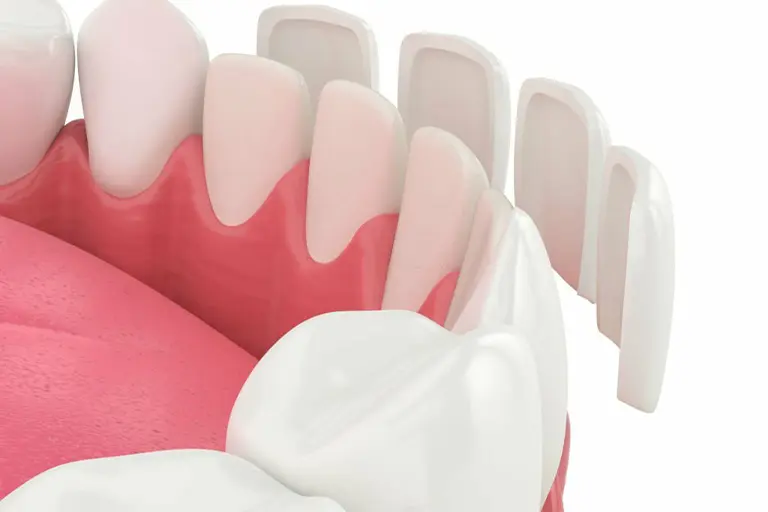What are veneers?
Veneers, also called porcelain veneers, are shell-like and tooth-colored structures used to improve the appearance of teeth. It is a popular treatment in cosmetic dentistry that is used in treating stained, discolored, gapped, and deformed teeth. Veneers are made up of porcelain, which is a type of ceramic.
For having porcelain veneers, your teeth/tooth should be drilled to make room for veneers to be bonded on your teeth. Then your dentist attaches the customized porcelain veneer to the prepared teeth using the composite resin, which is the common adhesive for this purpose. This procedure will take about 3 sessions and require temporaries (temporary veneers) to be worn until your veneers are made in the meantime.
There is also another veneering technique with composite veneer. It is different from both porcelain veneers and Lumineers. For composite veneers, the dentist directly applies the material to your teeth (direct restoration). Then the material is light cured and shaped to give you a new appearance for your teeth.
What are Lumineers?
Lumineers are a brand of veneers that require no or less tooth reduction. They are often called “no-prep” veneers and are thinner than traditional veneers, the size of contact lenses. If you don’t want to have your teeth drilled down, Lumineers is the one to choose instead of traditional veneers. They are manufactured by DenMat dental laboratory and are made up of cerinate porcelain.
What are the differences between Lumineers and veneers?

The main differences between Lumineers and veneers are:
Tooth preparation
For veneers, your dentist prepares your natural teeth by carving enamel to get enough room and good bond for its application. But there is no tooth reduction and less preparation to apply Lumineers on your teeth. They are directly bonded without tooth shaving process.
Shape and size
Veneers are thicker than Lumineers. The thickness of porcelain veneers can range from 0.5,0.8mm or 1.5mm, but Lumineers are ultra-thin, normally between 0.3mm to 0.5mm.
Translucency
Because of their thinness, Lumineers are more translucent and transparent. Therefore, they are more suitable for less severe tooth discolorations.
Cost
On average, traditional veneers can cost $1,000 to $2,500 per tooth. The cost of Lumineers can range anywhere between $800 and $2,000 per tooth.
Pros and cons of Lumineers vs veneers
Veneers
Pros
| Better at matching tooth color and shade because it is opaque |
| Best option for severe tooth stains and discoloration |
| Excellent for greater tooth deformity and damage |
| Feel more natural |
Cons
| Invasive procedure. Tooth reduction is necessary for veneer bonding |
| more expensive |
| Treatment is longer |
Lumineers
Pros
| Less invasive. No natural tooth trimming and removal of enamel is needed Faster preparation and easy application Less expensive g tooth color and shade because it is opaque |
| Best option for severe tooth stains and discoloration |
| Excellent for greater tooth deformity and damage |
| Feel more natural |
Cons
| Not suitable for certain cases of misalignment and malformation Not a good option for badly stained teeth |
| Limited ability to change color and shade |
| May feel bulkier due to no-prep teeth |
Who is not a good candidate for Lumineers?
Your cosmetic dentist will tell if you are qualified for getting Lumineers or not. Some conditions like bruxism or teeth grinding habits can put Lumineers at more risk of failure. As a result, you should wear a mouth guard (night guard) to prevent any damage.
In addition, you are likely not a candidate for Lumineers if you have:
- sever cases of teeth irregularities, misalignment, crooked teeth
- complex bite problems

What can veneers and Lumineers do to your smile?
Your cosmetic dentist can determine whether to get Lumineers teeth or traditional porcelain veneers to get the smile you want. In fact, both Lumineers and porcelain veneers are excellent options that can make you happy about the cosmetic appearance of your teeth.
Durable and long lasting
One key feature of veneers and Lumineers is durability and long-lasting effects. There is a debate over which lasts longer. Both of them have the potential to live with you for 10 to 15 years. Traditional porcelain veneers will last more years and can stay firm for up to 20 years. This is all achieved with good care and improved oral and dental health management.
Excellent smile makeover option
Once you are eligible for either veneers or Lumineers, you will enjoy having an enhanced, beautiful appearance for your smile.
A great solution for uneven tooth shapes and stained teeth
Depending on whether you have minor cases of misalignment or staining on your teeth, Lumineers and Veneers are a great solution to correct teeth imperfection and achieve a cosmetic look. Chipped teeth, crookedness, small teeth, tooth discoloration and other similar issues with your teeth are masked and coated with no-prep or traditional veneers very well.
Highly aesthetic and feel natural
Due to the materials used for veneers in general (porcelain and glass dominated materials), you will have glassy, natural-looking teeth.
Color stable
Unlike composite, porcelain veneers and Lumineers are stain resistant thanks to its compositions. They will resist well against colors and are not easily discolored.
Abrasion resistant
Wear and tear is common for every surface of teeth. Veneers and Lumineers, if well cared for and preserved, can withstand the abrasions and keep their shape for a longer time compared to other cosmetic restorations.
Lumineers vs. veneers process and application
In the beginning, your dentist will discuss whether or not you are the right candidate for Lumineers vs. Veneers or traditional porcelain veneers.
Your entire mouth and teeth are examined and checked for signs of gum diseases, cavities, and tooth crookedness or irregularities.
Once your teeth are healthy take veneers, the only prior dental work might be a professional tooth cleaning to remove plaque build-ups or whitening to clean teeth, which also prevents uneven contrast between the colors of your natural teeth and veneers.
Lumineers process
For Lumineers, the procedure will normally take 2 visits. At the first visit, the dentist will take an impression of your teeth and send it to the lab, where Lumineers are made. The dentist can do a wax-up on the impression and provides you with a trial smile.
At the second visit, Lumineers are bonded in place using adhesives and with the help of a blue light, which is shone regularly on your mouth to speed up the process and activate the adhesive better.
Treatment is done and you may be recalled later to have your Lumineers examined. This is to ensure that they are in a perfect position, so no problem will occur.
Watch the below video of the Lumineers’ step-by-step procedure:
Veneers process
For veneers, the procedure will be done in 3 visits. Your first appointment will go around the check-ups and examinations by the dentist. At the second visit, your teeth are prepared and tooth reduction is performed. Your dentist will remove around 0.5mm or more of natural enamel on the surface of teeth. After that, the impression is taken of your teeth and sent to the lab.
Your dentist gives you temporary veneers, which protect your teeth against tooth sensitivity and other issues.
Likewise, you will have a trial smile to know whether you like the shade, size, and all that is necessary for your desired smile
At the next visit, you are scheduled to bond the customized veneers on. The procedure is similar to Lumineers. Through light curing, polishing, and other finishing processes, the dentist places the veneers on the teeth.
Frequently asked questions around Lumineers
Lumineers act as a tooth coating for minor deformities and discoloration. Neither Lumineers nor traditional veneers work as an alternative to restorations like dental crowns or orthodontic braces/Invisalign.
Crowns cover all parts of the tooth and are a type of dental restoration for severely damaged teeth, which are caused by cavities or other problems like injuries. In contrast, veneers only mask the front surface of the teeth.
Veneers are quicker solutions for milder forms of spacing, crookedness, and chipping, which have affected the smile. To align your teeth and root out the problem, you need to have orthodontic treatment and use either braces or Invisalign.
Since Lumineers are considered a cosmetic and elective treatment, they are not usually covered by dental insurance.
The price of Lumineers varies based on where you live, your dentist, the type of treatment you have, and other issues. But you should expect a price range from $800 to $2,000 per tooth. For traditional porcelain veneers, the cost can be $1,000 to $2,500 for each tooth.
Although Lumineers have fewer side effects compared to traditional veneers, you are still prone to some risks like gum diseases, difficulty in cleaning teeth, and tooth sensitivity.
Having veneers, in general, may allow for plaque buildups to get trapped in between the gum lines. Therefore, you should have a strict daily oral hygiene practice and clean your teeth regularly. Brush with fluoride toothpaste twice a day and floss carefully to prevent plaque accumulation in hard-to-reach areas surrounding the teeth and Lumineers.
